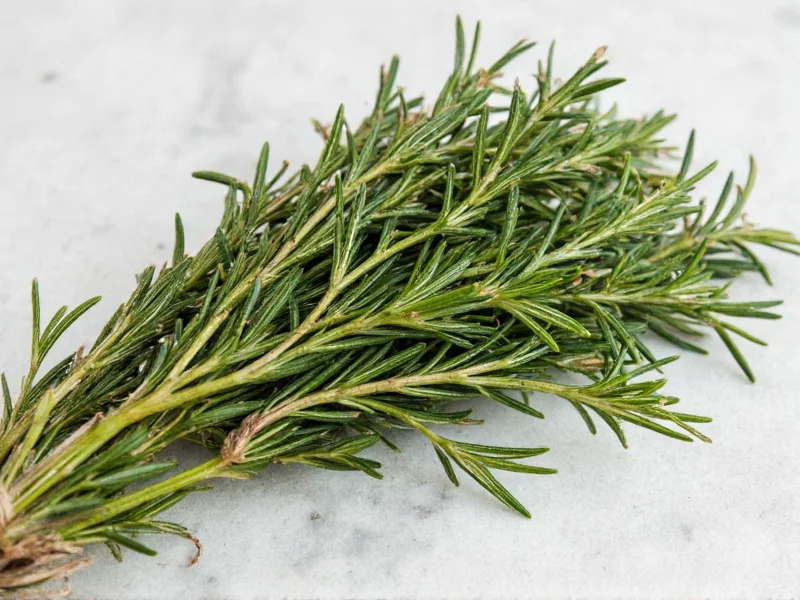Understanding rosemary's shelf life is essential for home cooks and gardeners who want to maximize this versatile herb's flavor and avoid food waste. Whether you've harvested fresh rosemary from your garden or purchased dried rosemary from the store, knowing how to properly assess and store it ensures you get the most from this aromatic Mediterranean herb.
How to Identify Spoiled Rosemary
Recognizing when rosemary has gone bad prevents potential food safety issues and ensures optimal flavor in your dishes. The indicators differ slightly between fresh and dried varieties.
Signs Fresh Rosemary Has Spoiled
- Color changes - Fresh rosemary should be vibrant green. Yellowing, browning, or black spots indicate deterioration
- Texture issues - Slimy or mushy stems and leaves are clear signs of spoilage
- Mold growth - Any visible fuzzy white, green, or black mold means the herb should be discarded immediately
- Odor loss - Fresh rosemary should have a strong, pine-like fragrance. If it smells musty or has no scent, it's past its prime
- Wilted appearance - While some wilting occurs naturally, severely limp or shriveled sprigs indicate age
Signs Dried Rosemary Has Gone Bad
- Faded color - High-quality dried rosemary maintains a deep green color. Significant fading suggests flavor loss
- Loss of aroma - Rub dried rosemary between your fingers. If you detect little to no fragrance, it's lost potency
- Mold or moisture - Any signs of moisture or mold in dried rosemary packaging require immediate disposal
- Bitter taste - Properly stored dried rosemary should have a pleasant, piney flavor. A noticeably bitter or off taste indicates spoilage
| Rosemary Type | Optimal Storage | Refrigerator Shelf Life | Pantry Shelf Life | Freezer Shelf Life |
|---|---|---|---|---|
| Fresh Rosemary | In water like flowers or wrapped in damp paper towel | 1-2 weeks | N/A | 6-12 months |
| Dried Rosemary | Airtight container away from light and heat | N/A | 1-3 years | 3-4 years |
| Rosemary Oil Extract | Cool, dark place in dark glass bottle | N/A | 1-2 years | 2-3 years |
Maximizing Rosemary's Shelf Life
Proper storage techniques dramatically extend rosemary's freshness and flavor. Understanding the specific requirements for fresh versus dried rosemary helps prevent premature spoilage.
Storing Fresh Rosemary
The best method for preserving fresh rosemary mimics how florists keep cut flowers alive. Trim the stems and place them upright in a glass with about an inch of water, like a bouquet. Cover loosely with a plastic bag and store in the refrigerator. Change the water every 2-3 days. Alternatively, wrap the sprigs in a slightly damp paper towel and place them in a perforated plastic bag in your vegetable drawer.
Storing Dried Rosemary
Dried rosemary maintains its potency longest when protected from the four enemies of dried herbs: light, heat, air, and moisture. Store in an airtight container made of dark glass or opaque material. Keep in a cool, dark pantry away from your stove or dishwasher. Properly stored dried rosemary retains good flavor for 1-3 years, though peak quality occurs within the first year.
Food Safety Considerations
While consuming slightly old rosemary typically won't cause illness, moldy or severely spoiled rosemary can potentially harbor harmful bacteria or mycotoxins. When in doubt, throw it out. Never consume rosemary with visible mold growth, as some molds produce toxins that aren't destroyed by cooking.
Unlike some foods where "best by" dates are conservative, herbs like rosemary show clear visual and olfactory signs when they've spoiled. Trust your senses—discard rosemary that looks, smells, or feels off. Remember that dried rosemary doesn't technically "go bad" in the sense of becoming unsafe, but it does lose flavor and potency over time.
Creative Ways to Use Rosemary Before It Spoils
If you have an abundance of fresh rosemary approaching the end of its prime, several preservation methods can extend its usability:
- Freezing - Chop fresh rosemary and freeze in ice cube trays with olive oil or water
- Infused oils - Create rosemary-infused olive oil for cooking (properly stored to prevent botulism risk)
- Vinegar infusions - Make aromatic rosemary vinegar for dressings
- Drying - Hang fresh sprigs upside down in a dark, well-ventilated area to create your own dried rosemary
- Compound butter - Mix chopped rosemary into softened butter and freeze for future use
Understanding Rosemary's Natural Lifecycle
Rosemary is a hardy perennial herb that naturally contains antimicrobial compounds, which is why it has relatively good shelf stability compared to more delicate herbs like basil or cilantro. However, these natural preservatives only go so far once the plant material is harvested.
The essential oils that give rosemary its distinctive aroma and flavor gradually evaporate over time, especially when exposed to air, light, and heat. This is why properly stored dried rosemary maintains quality longer than many other dried herbs—its natural chemistry provides some protection against rapid deterioration.











 浙公网安备
33010002000092号
浙公网安备
33010002000092号 浙B2-20120091-4
浙B2-20120091-4